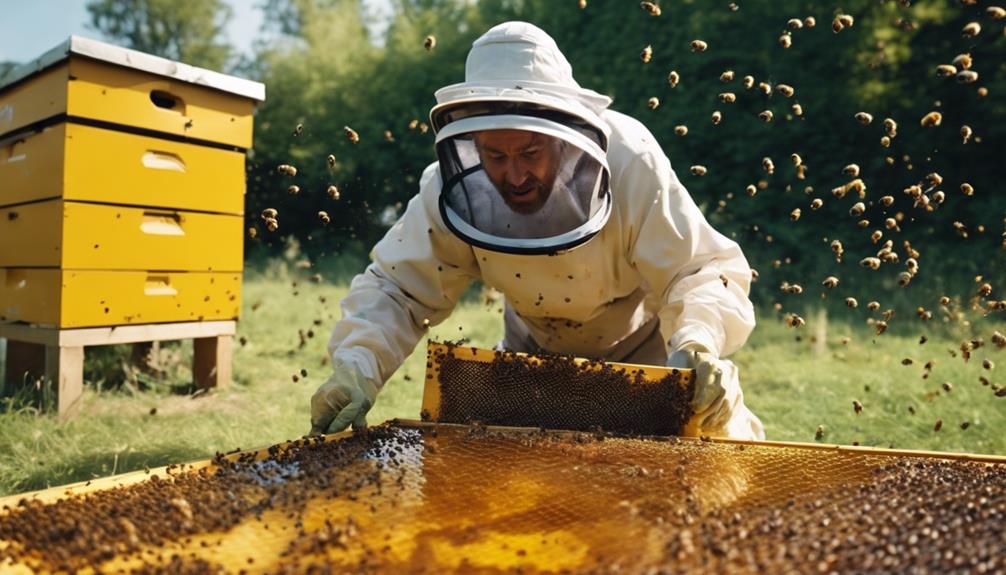When facing a swarm of bees, it’s essential to steer clear of actions that might trigger their defense mechanisms. Running in a straight line is a good idea since erratic movements can provoke them. Avoid flailing or swatting at the bees, as this can make matters worse. Jumping into water isn’t a wise escape plan either, as bees will wait for you to resurface. Seek shelter in enclosed spaces rather than open areas, and keep noise levels low to avoid agitating the swarm. Remember, this is just the beginning of bee safety tips…
Main Points
- Do not swat at the bees as it can provoke them.
- Avoid making loud noises or sudden movements.
- Never disturb the swarm by flapping or shooing at them.
- Don’t run erratically, stay calm, and move slowly.
- Avoid hiding in open spaces where bees can easily find you.
Running in a Straight Line
When faced with a swarm of bees, our best course of action is to swiftly move away in a straight line to prevent provoking them. Bees can be quite protective of their hive, and the last thing we want is to anger them further.
Remember, bees can chase for a short distance, so maintaining a steady pace while running is key. It’s like a calm retreat from a buzzing battlefield – no sudden movements, just a smooth exit.
Flailing or Swatting
Flailing or swatting at bees can escalate the situation and increase the risk of being stung due to provoking defensive behavior. When dealing with a bee swarm, it’s essential to remain calm and avoid sudden movements that can be perceived as threats.
Here are some tips to handle bees without aggravating them further:
- Stay still and move away slowly to disengage from the bee swarm.
- Avoid waving your arms or swatting at the bees, as this can trigger defensive reactions.
- Use gentle movements to create distance between yourself and the bees.
- Keep your hands away from your face to prevent accidental stings.
- Seek shelter indoors or in a car if the bees are persistent in their approach.
Jumping Into Water

We’ve all witnessed those action movies where a character plunges into water to evade danger, but in the case of a swarm of bees, that move mightn’t be the best idea.
Bees aren’t easily discouraged by water; they’ll patiently wait for you to resurface, prepared to continue their stinging mission.
Plunging into water not only exposes you to bee stings but also increases the risk of drowning, making it a double whammy in terms of danger.
Water and Bee Stings
Sometimes, jumping into water during a bee attack can worsen the situation instead of providing safety. It’s essential to understand that bees can hover above the water, waiting for you to resurface and continue their attack. To stay protected during a bee swarm, it’s best to avoid bodies of water like pools or lakes and opt for seeking shelter on land. Water can hinder rescue efforts and make it challenging for help to reach you in a bee emergency. Remember, staying on land offers a safer option when dealing with bee stings.
- Bees can wait for you to resurface after jumping into water.
- Bees can hover above the water’s surface during an attack.
- Avoid bodies of water like pools or lakes for safety.
- Choose land over water when seeking shelter from a bee swarm.
- Water can impede rescue efforts during a bee emergency.
Bees Follow to Water
When encountering a bee swarm, it’s crucial to understand that bees will follow you to water if you jump in during an attack. Water doesn’t deter these persistent insects; they can hover above the surface, waiting for you to resurface.
So, avoid bodies of water like pools or lakes as bees can still attack you there. It’s safer to seek shelter on land rather than risking a bee-filled pursuit into the water. Remember, jumping into water during a bee attack not only puts you at risk but also complicates rescue efforts.
Stay on dry land, stay calm, and slowly move away from the bee swarms to safety.
Risk of Drowning
Jumping into water during a bee attack poses a significant risk of drowning due to bees’ ability to hover above the surface and wait for the victim to resurface. Here are some important points to keep in mind when facing a bee swarm near water:
- Bees can still sting you while you’re in the water.
- Avoid bodies of water like pools or lakes as bees can still reach you.
- Seeking shelter on land is a safer option than risking drowning in water.
- Water can hinder rescuers from reaching you promptly.
- Stay calm and find a safe, dry place to wait out the bee swarm instead of risking your safety in the water.
Hiding in Open Spaces

When confronted with a swarm of bees, keep in mind that hiding in open spaces like tall grass or bushes can attract more unwanted attention from these buzzing creatures. Bees are quick to spot movement in open areas, and this may make them feel threatened, leading to more aggressive behavior.
To stay safe, it’s best to seek refuge in enclosed spaces where bees will have a harder time reaching you, keeping calm and collected throughout the encounter.
Open Areas Attract Bees
In open areas, bees are naturally drawn due to the visibility and sunlight they offer, making them ideal for navigation and scouting potential nesting sites. Here are some key points to remember when dealing with scouting bees:
- Bees may use open spaces as rest stops during their search for a new home.
- Open areas provide bees with ample opportunities to feed on nectar and pollen.
- Be cautious when moving in open spaces during bee swarms as bees can easily spot sudden movements.
- Avoid lingering in open areas where bees are actively scouting for nesting spots.
- Seek refuge in enclosed spaces to protect yourself from bee stings and minimize the risk of encountering scouting bees.
Seek Enclosed Spaces
One effective strategy during a bee swarm is to quickly seek refuge in enclosed spaces for safety and protection. Bees struggle to navigate through closed windows and doors, making indoors a secure shelter until the swarm disperses. It’s much safer than attempting to hide in open spaces where the bees can easily access you.
Remember, if you find yourself outdoors with a swarm of bees and can’t reach a building, try covering your face and head with clothing for some protection. Avoid seeking refuge in tall grass or dense vegetation as this can aggravate the bees further.
When faced with a swarm of bees, staying calm and seeking enclosed spaces is the smartest move for your safety and well-being.
Stay Calm, Not Frantic
To stay safe during a bee swarm, it’s crucial to stay calm and avoid frantic movements that may provoke the bees. Remember, bees fly, and sudden actions can be misinterpreted as threats. Here are some tips to help you navigate a bee swarm safely:
- Stay still and composed to minimize the risk of being stung.
- Avoid hiding in open spaces like tall grass or dense vegetation where bees can easily access you.
- Seek shelter in enclosed areas such as a car or building to protect yourself from the bees.
- Wait patiently for the bees to disperse naturally.
- Running or panicking in open areas can escalate the situation and increase the chances of getting stung.
Ignoring Enclosed Shelter

When facing a bee swarm, prioritizing safety means not disregarding the protection of enclosed shelter. Bees can’t easily penetrate closed windows or doors, making indoors a vital haven during a swarm. Waiting inside until the bees disperse is a smart strategy to steer clear of stings.
If you find yourself without indoor shelter, cover your face and head with clothing for some defense. Remember, tall grass and thick vegetation won’t shield you from determined bees. Seeking assistance if shelter is inaccessible is essential to ensuring your safety in a bee swarm.
Provoking With Noise
When around a bee swarm, it’s important to remain mindful of the impact loud noises can have on provoking the bees. Here are some key points to keep in mind regarding noise and bee swarms:
- Bees can be easily provoked by loud noises, such as shouting or banging on objects.
- Vibrations from loud noises can agitate bees, making them more defensive and prone to stinging.
- Loud noises can disrupt bees’ communication within the swarm, leading to confusion and potential aggression.
- Avoid using power tools or playing loud music near a swarm to prevent provoking the bees unnecessarily.
- Maintaining a calm and quiet environment around bees is essential for minimizing the risk of aggression and ensuring everyone’s safety.
Disturbing the Swarm

Disturbing a swarm of bees can quickly escalate the situation, leading to defensive behavior and potential stinging. When a bee swarm is in transit or resting, it’s best to observe from a safe distance and avoid actions that may agitate them.
Bees are simply trying to relocate and may not be looking to cause trouble. Flapping your arms or trying to shoo them away can make matters worse. Remember, bees play an essential role in our ecosystem, so it’s vital to respect their space.
Disregarding Safety Measures
Neglecting safety measures around a swarm of bees can significantly increase the risk of provoking defensive behavior and getting stung. When it comes to bee removal, it’s essential to prioritize safety for both yourself and the bees. Here are some vital safety measures to keep in mind:
- Wear protective clothing such as bee suits, gloves, and veils.
- Avoid swatting at the bees, as this can agitate them further.
- Work slowly and calmly to minimize disturbances to the swarm.
- Keep children and pets at a safe distance to prevent any accidents.
- Seek professional help if the situation feels overwhelming or if you’re unsure how to proceed.

Hello! My name is Noel Calvin. I graduated from UCLA and now work as a writer at Launch Ninjas. I write blog posts that inspire and guide our readers in their entrepreneurial pursuits. I live in Pleasantville, NJ, with a peaceful yet lively atmosphere that inspires me.
Writing stories is more than just a job for me. It allows me to share my observations and satisfy my curiosity about the world. I combine my analytical skills with creative enthusiasm to delve into technology trends and startup stories. But my life isn’t limited to screens and keyboards. I value loyalty, passion, and a touch of old-fashioned charm, which I infuse into every narrative I create.
I love spending time in my garage, jamming with my band when I’m not writing. Playing the guitar and singing bring me immense joy. I also enjoy capturing ordinary and extraordinary moments through my camera lens and exploring new culinary adventures that excite my taste buds. I’m always seeking new experiences.
My family is very important to me. Joyful Sunday brunches filled with laughter and intense board game nights keep me grounded, reminding me of life’s simple pleasures.
In my world, every moment is an opportunity for discovery. Every discovery is a story worth sharing, whether a heartfelt moment at home or the pulse of technological innovations. Join me as I navigate through life, one blog post, one guitar strum, and one heartwarming family dinner at a time.


